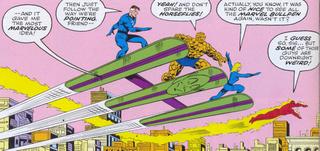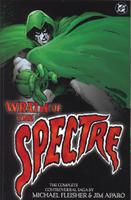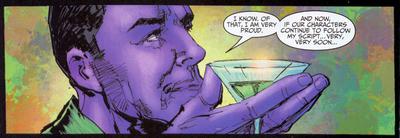- - - - - - - - - - - - - - - - - - - - - - - - - - - - - - - - - - - - - - - - - - - - - - - -
 In this issue:
In this issue:reviews of GØDLAND #1 and JLA: Classified #10 /
notes on religious motifs in Rags's cover to JLA #115, five sure-fire relaunch schemes for Batman and the Outsiders, and awesome, brilliant people with impeccable taste / rants about my own bloody shortsightedness
- - - - - - - - - - - - - - - - - - - - - - - - - - - - - - - - - - - - - - - - - - - - - - - -

reviews
GØDLAND #1 (Image)
Joe Casey (Writer) / Tom Scioli (Artist) / Bill Crabtree (Colorist) / Comicraft/Rob Steen (Letterer) / Richard Starkings (Designer)
 Kirby purists will snort, but I think GØDLAND’s nifty.
Kirby purists will snort, but I think GØDLAND’s nifty. In an insightful interview with Matt Fraction at CBR, Joe Casey describes the series as “Grand Kirby Spectacle mixed with the particular bent I happen to get my rocks off writing.” That, True Disbeliever, is a pretty fair summary of what we get in GØDLAND #1, a book that runs 1960s Marvel dialogue through a metafictional time warp while keeping the King’s pulse-pounding layouts and trademark energy dots front and centre.
The story concerns some big (BIG!) doings: former American astronaut Adam Archer has acquired the power cosmic after surviving a mind-bending close encounter on Mars and, at the beginning of this issue, is called into action to investigate a mysterious meteor that has crashed into the Great Wall of China. Casey give us big battles, big mysteries, and big villains. Launching another salvo in the war on “decompression,” Casey also gives us big subplots concerning, among other things, Adam’s sisterly trinity (straight arrow Neela, anti-establishment brat Angie, and acerbic den mother Stella), purple-armored alien scientists and their vats of reptilian wardogs, some costumed fellow named Crashman, and the paternity of sadistic superdom Discordia.
 As much fun as Casey’s tongue-in-cheek tweaking of superhero conventions provides, and as much of an intellectual punch it promises to pack in the future (see below), the main attraction of the series at this point is the lightening-bolt-to-your-cranium sublimity of Tom Scioli’s stunning artwork: an eerie channeling of Kirby, brought gorgeously to life by Bill Crabtree’s award-worthy coloring. Casey’s cosmos-spanning story gives Scioli an abundance of weird scenes and exotic settings to draw, and Scioli’s high-powered renderings are transformed by Crabtree into pages so vibrant that I defy even those who would cry “pastiche!” to affect indifference. Don’t be fooled by the bland cover design: this is one beautiful book.
As much fun as Casey’s tongue-in-cheek tweaking of superhero conventions provides, and as much of an intellectual punch it promises to pack in the future (see below), the main attraction of the series at this point is the lightening-bolt-to-your-cranium sublimity of Tom Scioli’s stunning artwork: an eerie channeling of Kirby, brought gorgeously to life by Bill Crabtree’s award-worthy coloring. Casey’s cosmos-spanning story gives Scioli an abundance of weird scenes and exotic settings to draw, and Scioli’s high-powered renderings are transformed by Crabtree into pages so vibrant that I defy even those who would cry “pastiche!” to affect indifference. Don’t be fooled by the bland cover design: this is one beautiful book. The quality of Crabtree’s work deserves special mention here, for his coloring provides a subliminal but potent emotional score for the issue, becoming an integral component of the book’s affective power. His technique is to treat each multi-paneled page like a single painting--a painting that is often connected to adjacent pages in subtle, complicated ways.
The quality of Crabtree’s work deserves special mention here, for his coloring provides a subliminal but potent emotional score for the issue, becoming an integral component of the book’s affective power. His technique is to treat each multi-paneled page like a single painting--a painting that is often connected to adjacent pages in subtle, complicated ways.  For instance, in an extraordinary two-page flashback of Adam triggering an ancient alien machine in a Martian cave (done almost entirely in greys and greens), Crabtree makes the facing pages perfect chromatic inversions of each other to reinforce Adam’s through-the-looking-glass experience of being overwhelmed by sinister spectral versions of himself.
For instance, in an extraordinary two-page flashback of Adam triggering an ancient alien machine in a Martian cave (done almost entirely in greys and greens), Crabtree makes the facing pages perfect chromatic inversions of each other to reinforce Adam’s through-the-looking-glass experience of being overwhelmed by sinister spectral versions of himself.  A later two-page sequence depicting Discordia’s ice fortress in the Arctic Circle is even more impressive. In this instance, Crabtree uses a cold blue palette on the upper quadrants and a warm orange palette on the lower ones to divide the two pages horizontally. In this way, the coloring complements the action depicted in the panels: the blue-over-orange conveys the impression of an icy crust over a blistering inferno that is a visual metaphor for scarlet-clad ice-queen Discordia’s salacious torturing of Crashman inside her fortress dungeon.
A later two-page sequence depicting Discordia’s ice fortress in the Arctic Circle is even more impressive. In this instance, Crabtree uses a cold blue palette on the upper quadrants and a warm orange palette on the lower ones to divide the two pages horizontally. In this way, the coloring complements the action depicted in the panels: the blue-over-orange conveys the impression of an icy crust over a blistering inferno that is a visual metaphor for scarlet-clad ice-queen Discordia’s salacious torturing of Crashman inside her fortress dungeon. 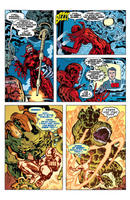 (Intriguingly, the scene shifts to another battle in the lower quadrant of the second page of this spread, but the continuity of the orange palette suggests that these scenes might be more closely related than they appear. This detail is a further sign of the care with which the coloring has been executed, for the oranges of this two page-spread pick up the color scheme of this other fight sequence that has been ongoing throughout the issue.)
(Intriguingly, the scene shifts to another battle in the lower quadrant of the second page of this spread, but the continuity of the orange palette suggests that these scenes might be more closely related than they appear. This detail is a further sign of the care with which the coloring has been executed, for the oranges of this two page-spread pick up the color scheme of this other fight sequence that has been ongoing throughout the issue.)The obvious stumbling block for a series like this will be the perception that GØDLAND is just a lame Kirby rip-off or another tedious “homage.” That Scioli sees imitation as the sincerest form of flattery is undeniable. But for many reasons, this should not be cause for scorn. Postmodern art is almost by definition non-original and hyperreal, so unless one subscribes to the prescriptive view that postmodernism is necessarily shallow and pernicious (in which case “postmodernism” becomes an evaluative rather than a descriptive category), there’s no call for a rush to judgment. Based on the evidence of the first issue, moreover, I think we should take Casey at his word when he says, “if the series was just a pastiche, it wouldn’t be worth doing for me,” and also when he tells us that “the Kirby art riffs are a storytelling tool in the same way that captions and thought balloons are storytelling tools.” If we take Casey seriously here, and obviously I’m so inclined, then the question GØDLAND poses is not “do we need another Kirby tribute, no matter how pretty it might be?” but rather, “what kind of postmodernism is this, and what kind of conversation is it having with Kirby?”
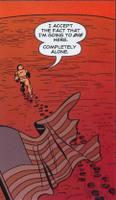 It’s too soon to tell how interesting this conversation will be, or exactly what form it will take, but there are already a number of promising signs in the script that make me want to find out how Casey, Scioli, and Crabtree will develop it. The promise of the series for me is crystallized by the title, which plays not simply on the gods-among-us theme common to the Kirby oeuvre, but also on Kirby’s own deified status. In both cases, the negated O in “GØD” announces Casey’s iconoclastic intent, but in a way that suggests something more complex than either homage or parody. GØDLAND promises to put Kirby “under erasure”--that is, to make him paradoxically present and absent simultaneously, crossing him out in such a way that requires us to see both the original and the line that bars it. This is what Casey means, I think, when he refers to the Kirby art riffs as storytelling tools. We will see them, but they will no longer mean precisely what we expect them to.
It’s too soon to tell how interesting this conversation will be, or exactly what form it will take, but there are already a number of promising signs in the script that make me want to find out how Casey, Scioli, and Crabtree will develop it. The promise of the series for me is crystallized by the title, which plays not simply on the gods-among-us theme common to the Kirby oeuvre, but also on Kirby’s own deified status. In both cases, the negated O in “GØD” announces Casey’s iconoclastic intent, but in a way that suggests something more complex than either homage or parody. GØDLAND promises to put Kirby “under erasure”--that is, to make him paradoxically present and absent simultaneously, crossing him out in such a way that requires us to see both the original and the line that bars it. This is what Casey means, I think, when he refers to the Kirby art riffs as storytelling tools. We will see them, but they will no longer mean precisely what we expect them to.What might they mean? Earlier this week, I wrote about another group of creators who paid tribute to Kirby by locating him in a mythic past, by casting him as founding father and presiding spirit of the Marvel bullpen. GØDLAND’s Kirby appears to be something quite different. For Casey and Scioli’s hyperrealist retooling of classic Marvel suggests that they view Kirby not merely as a creative luminary from the past, but also, in sense, as our contemporary. This is neither pastiche nor nostalgia, in other words, because Kirby (like Casey’s other creative crush, Kafka) was a postmodernist before the fact. His weirdly contorted “Futurist” machines and surreal, nightmarish visions may have been products of the trippy sixties, but they speak directly to our science-fiction present in the increasingly bizarre here and now of postmodernity.
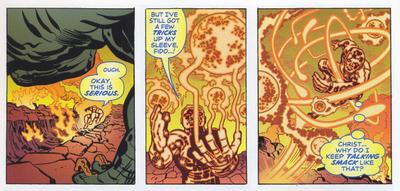 Whether or not GØDLAND will end up moving beyond the amusing metafictional hijinks of its premier issue to explore this territory fully and prove the Kirby purists wrong remains to be seen--but the smart money’s on Casey.
Whether or not GØDLAND will end up moving beyond the amusing metafictional hijinks of its premier issue to explore this territory fully and prove the Kirby purists wrong remains to be seen--but the smart money’s on Casey.JLA: Classsified #10 (DC Comics)
Warren Ellis (Writer) / Butch Guice (Artist) / David Baron (Colorist) / Phil Balsman (Letterer)
 Lexcorp employees are killing themselves in droves and Lois and Clark are on the case. Meanwhile, Batman investigates the murder of a Defense Industry Contractor, and Wonder Woman gets a very nasty surprise. So begins the Ellis/Guice JLA arc, “New Maps of Hell,” and it’s well worth your nickel. In fact, it’s probably the best “big three” DC book on the stands this week, despite riveting installments of trinity-shattering goodness in Wonder Woman #219 and The Omac Project #4.
Lexcorp employees are killing themselves in droves and Lois and Clark are on the case. Meanwhile, Batman investigates the murder of a Defense Industry Contractor, and Wonder Woman gets a very nasty surprise. So begins the Ellis/Guice JLA arc, “New Maps of Hell,” and it’s well worth your nickel. In fact, it’s probably the best “big three” DC book on the stands this week, despite riveting installments of trinity-shattering goodness in Wonder Woman #219 and The Omac Project #4.The cover tells us that “it begins with the Batman,” but don’t believe it. It begins with Ellis’s wonderful take on Lois and Clark who banter here like a real married couple and behave like genuine reporters. The scenes between them and Perry in the Daily Planet offices are the most fun I’ve had with these characters in a very long time.
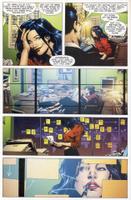 What really makes the issue, though, is Butch Guice’s sumptuous art. I’ve been a huge fan of his work since Crossgen’s late, lamented Ruse, and if possible, he’s gotten even better since then. His establishing shots of Metropolis, Gotham, and Themyscira are stunning, and his detailed backgrounds give each city an incredible sense of concreteness and depth. As one might expect, he draws Clark, Bruce, and Diana expertly, but I especially love his Lois Lane.
What really makes the issue, though, is Butch Guice’s sumptuous art. I’ve been a huge fan of his work since Crossgen’s late, lamented Ruse, and if possible, he’s gotten even better since then. His establishing shots of Metropolis, Gotham, and Themyscira are stunning, and his detailed backgrounds give each city an incredible sense of concreteness and depth. As one might expect, he draws Clark, Bruce, and Diana expertly, but I especially love his Lois Lane. There’s a wordless three panel sequence of Lois alone in her office, working out the mystery of the twenty Lexcorp suicides that is truly memorable.
This one’s a gem.

notes
Allusion Watch: Rags’s Assumption of Batman
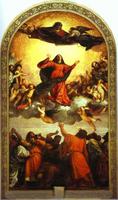 I finally put my finger on why I’m so enamored of Rags’s cover for JLA #115 from a couple of months ago: he’s depicted DC’s god-like pantheon with the grandeur, power, and feeling of religious art. I don’t know enough art history to say if this cover is based on a specific painting, but the style of its composition seems closest to that of Renaissance or Baroque painting.
I finally put my finger on why I’m so enamored of Rags’s cover for JLA #115 from a couple of months ago: he’s depicted DC’s god-like pantheon with the grandeur, power, and feeling of religious art. I don’t know enough art history to say if this cover is based on a specific painting, but the style of its composition seems closest to that of Renaissance or Baroque painting.  In works depicting religious scenes like Titian’s Assumption of the Virgin (1516-18) (above), Rubens’s Descent from the Cross (1611-12) (right), or Pietro da Cortona’s Glorification of the Reign of Urban VIII (1633-39) (below), figures are naturally arranged along a vertical plane to convey the hierarchy of human and divine.
In works depicting religious scenes like Titian’s Assumption of the Virgin (1516-18) (above), Rubens’s Descent from the Cross (1611-12) (right), or Pietro da Cortona’s Glorification of the Reign of Urban VIII (1633-39) (below), figures are naturally arranged along a vertical plane to convey the hierarchy of human and divine.  The divine focal point of the paintings is clearly appropriated (and complicated) by Batman’s ambiguous position on the cover (is it an ascent or a descent? are we witnessing the ascension of a human or the fall of a god?). Likewise, the awed, upturned faces of the figures near the bottom of the paintings, as well as the expressive, ecstatic poses of those closest to the divine figures are captured in Rags’s cover by Zatanna and Martian Manhunter respectively.
The divine focal point of the paintings is clearly appropriated (and complicated) by Batman’s ambiguous position on the cover (is it an ascent or a descent? are we witnessing the ascension of a human or the fall of a god?). Likewise, the awed, upturned faces of the figures near the bottom of the paintings, as well as the expressive, ecstatic poses of those closest to the divine figures are captured in Rags’s cover by Zatanna and Martian Manhunter respectively.  Also noteworthy is the use of space in both the cover and the paintings, all of which present the viewer with elaborate frames of human bodies around an empty gap at the centre of the image. The significance of this gap in the religious art should be obvious enough (especially in da Cortona’s painting, where it is given a luminous glow). In Rags’s work, however, it brilliantly suggests the hollowness at the core of the Justice League that Batman appears to be either escaping from or falling into in this incredible scene. DC: please sign Rags to a cushy contract...for life.
Also noteworthy is the use of space in both the cover and the paintings, all of which present the viewer with elaborate frames of human bodies around an empty gap at the centre of the image. The significance of this gap in the religious art should be obvious enough (especially in da Cortona’s painting, where it is given a luminous glow). In Rags’s work, however, it brilliantly suggests the hollowness at the core of the Justice League that Batman appears to be either escaping from or falling into in this incredible scene. DC: please sign Rags to a cushy contract...for life.A new BATO monthly? Try Five. Relaunch in 5… 4… 3… 2… 1…
 Okay, so the old-school hijacking of Winick’s Outsiders this week isn’t exactly a masterpiece, but the art by Will Conrad and Sean Parsons is moody and attractive, and Peter J. Tomasi’s story (something about a telepathic madman who detonates human bombs) is serviceable, despite the corny dialogue. What really matters here is that someone at DC (Tomasi?) was willing to pull a few of the old guard out of mothballs and thrust them momentarily into the spotlight at a time when fans have genuine cause to be optimistic that their neglected favorites from the ’eighties will finally be revived as decent, sometimes even spectacular, ongoing series.
Okay, so the old-school hijacking of Winick’s Outsiders this week isn’t exactly a masterpiece, but the art by Will Conrad and Sean Parsons is moody and attractive, and Peter J. Tomasi’s story (something about a telepathic madman who detonates human bombs) is serviceable, despite the corny dialogue. What really matters here is that someone at DC (Tomasi?) was willing to pull a few of the old guard out of mothballs and thrust them momentarily into the spotlight at a time when fans have genuine cause to be optimistic that their neglected favorites from the ’eighties will finally be revived as decent, sometimes even spectacular, ongoing series.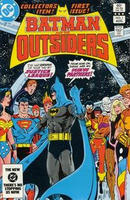 Don’t toy with us, DC. You know that there’s a legion of nostalgia hounds (okay, six, counting me) who are dying to see a well-conceived relaunch of the classic BATO team in 2006. Black Lightening, Katana, Geo-Force, the real Metamorpho, some version of Halo perhaps, a new and better Looker (what say you just give plain old Emily Briggs Looker’s powers but let her keep her own body?), and of course, Batman. Given the current unraveling of the JLA, the stage is set for Bruce Wayne to reconnect with the team he forged when he quit the League in disgust way back in BATO #1. Even if the rumors about Batman are true, this hardly nixes the possibility of a rekindled relationship between Bruce and his former colleagues.
Don’t toy with us, DC. You know that there’s a legion of nostalgia hounds (okay, six, counting me) who are dying to see a well-conceived relaunch of the classic BATO team in 2006. Black Lightening, Katana, Geo-Force, the real Metamorpho, some version of Halo perhaps, a new and better Looker (what say you just give plain old Emily Briggs Looker’s powers but let her keep her own body?), and of course, Batman. Given the current unraveling of the JLA, the stage is set for Bruce Wayne to reconnect with the team he forged when he quit the League in disgust way back in BATO #1. Even if the rumors about Batman are true, this hardly nixes the possibility of a rekindled relationship between Bruce and his former colleagues. Do we really need to revisit BATO, you ask? Let me put it this way: yes! There’s so much untapped story potential here, particularly in a DCU that’s turned its rich history of obscure and half-forgotten characters into one of its strongest assets. If I may be permitted to fantasize for a moment, here are five creative teams that could work wonders with Mike W. Barr and Jim Aparo’s colorful group of misfits:
Batman and the Outsiders
by Grant Morrison and Val Semeiks
 At the end of the day, Barr and Aparo’s series was simultaneously dark, weird, and quirky—a strange mixture that stemmed from the oddball pairing of the Dark Knight Detective with a brightly clad collection of troubled souls who all had hearts of gold. Morrison will of course be too busy designing sentient universes to step up to the plate here, but who better to write Metamorpho, to make Looker into a new Emma Frost, or to exploit the cosmic oddity of the Aurikles than the architect of New X-Men or Doom Patrol? Besides, who doesn’t want to see Grant Morrison’s New Wave? Semeiks is an underrated artist whose energetic layouts would be perfect for a book like this, and he and Morrison have worked well together before.
At the end of the day, Barr and Aparo’s series was simultaneously dark, weird, and quirky—a strange mixture that stemmed from the oddball pairing of the Dark Knight Detective with a brightly clad collection of troubled souls who all had hearts of gold. Morrison will of course be too busy designing sentient universes to step up to the plate here, but who better to write Metamorpho, to make Looker into a new Emma Frost, or to exploit the cosmic oddity of the Aurikles than the architect of New X-Men or Doom Patrol? Besides, who doesn’t want to see Grant Morrison’s New Wave? Semeiks is an underrated artist whose energetic layouts would be perfect for a book like this, and he and Morrison have worked well together before.Batman and the Outsiders
by Geoff Johns and Leonard Kirk
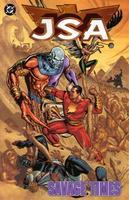
 Again, no hope in hell, but a man can dream. Johns and Kirk were my favorite writer/artist pairing on JSA, and their magnificent “Savage Times” arc even featured Ahk-Ton, a villainous ancient Egyptian version of Metamorpho who first appeared in BATO #17-18. Johns is the obvious choice for a nostalgia project like this and he seems to know his BATO history; he also has a sentimental streak that would not be out of place with these characters. In fact, there are many compelling reasons why Johns’s BATO would soar: his skill at making ridiculous villains menacing (no shortage of these in BATO!), his ability to make new versions of old characters feel simultaneously fresh and familiar (I’d love to see him reinvent both Halo and Looker), and his knack for subtle characterization generally (BATO was always a character-driven book and I’d love to see what kind of depth he’d bring to Pierce, Brion, Tatsu, and Rex). He could probably even devise an interesting way to bring back Dr. Jace after she was so disgracefully dispatched during the Millennium crossover nonsense when the series fizzled out. Come on Geoff: six series a month, would it really kill ya? Leonard Kirk’s beautiful pencils speak for themselves.
Again, no hope in hell, but a man can dream. Johns and Kirk were my favorite writer/artist pairing on JSA, and their magnificent “Savage Times” arc even featured Ahk-Ton, a villainous ancient Egyptian version of Metamorpho who first appeared in BATO #17-18. Johns is the obvious choice for a nostalgia project like this and he seems to know his BATO history; he also has a sentimental streak that would not be out of place with these characters. In fact, there are many compelling reasons why Johns’s BATO would soar: his skill at making ridiculous villains menacing (no shortage of these in BATO!), his ability to make new versions of old characters feel simultaneously fresh and familiar (I’d love to see him reinvent both Halo and Looker), and his knack for subtle characterization generally (BATO was always a character-driven book and I’d love to see what kind of depth he’d bring to Pierce, Brion, Tatsu, and Rex). He could probably even devise an interesting way to bring back Dr. Jace after she was so disgracefully dispatched during the Millennium crossover nonsense when the series fizzled out. Come on Geoff: six series a month, would it really kill ya? Leonard Kirk’s beautiful pencils speak for themselves.Huntress and the Outsiders
by Gail Simone and Chris Batista
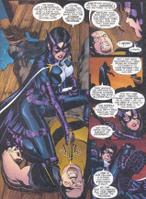 Batista’s doing a great job with straight-ahead superhero stuff on JLA right now and Simone’s Villains United is one of the most entertaining anti-team books on the stands. If anyone could make Katana the “it” character she deserves to be, it’s Simone. I have no defensible reason for proposing that Huntress lead the team besides the fact that I've always liked her, she has vague Bat-connections, plus the fact that Simone writes the heck out of her over on (guilty pleasure) Birds of Prey.
Batista’s doing a great job with straight-ahead superhero stuff on JLA right now and Simone’s Villains United is one of the most entertaining anti-team books on the stands. If anyone could make Katana the “it” character she deserves to be, it’s Simone. I have no defensible reason for proposing that Huntress lead the team besides the fact that I've always liked her, she has vague Bat-connections, plus the fact that Simone writes the heck out of her over on (guilty pleasure) Birds of Prey.Red Hood and the Outsiders
by Judd Winick and Will Conrad
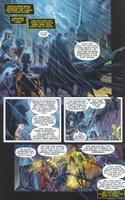 If there’s any team book suffering from an “identity crisis” these days, its Winick’s Outsiders, a book that has been uneven from the get-go, partly because it’s been played as a low-rent Titans and partly because few if any of the new characters have been crowd pleasers. His Batman, however, is firing on all cylinders, so why not combine the best of both worlds? Winick’s already played this game with us once, but having Jason Todd (mis)lead the team under the cowl of his former mentor or even as Red Hood might be interesting. Perhaps the current Outsiders series can still be salvaged, but my vote is that DC scrap the whole mess and start again with a retooled version of the classic team and one or two new ingredients. Winick’s taken a lot of shit for his writing on Outsiders, and I’m sorry to be adding to it here, but given the strength of his Batman I’m confident that he could make RHATO into a snappy noir adventure book.
If there’s any team book suffering from an “identity crisis” these days, its Winick’s Outsiders, a book that has been uneven from the get-go, partly because it’s been played as a low-rent Titans and partly because few if any of the new characters have been crowd pleasers. His Batman, however, is firing on all cylinders, so why not combine the best of both worlds? Winick’s already played this game with us once, but having Jason Todd (mis)lead the team under the cowl of his former mentor or even as Red Hood might be interesting. Perhaps the current Outsiders series can still be salvaged, but my vote is that DC scrap the whole mess and start again with a retooled version of the classic team and one or two new ingredients. Winick’s taken a lot of shit for his writing on Outsiders, and I’m sorry to be adding to it here, but given the strength of his Batman I’m confident that he could make RHATO into a snappy noir adventure book.Batman and the Outsiders
by Keith Giffen
 And finally, an oddball choice for an oddball book. The very dark, very adult Legion vol. 4, which Keith Giffen worked on with Tom Bierbaum, Mary Bierbaum, and Al Gordon back in the late 80s and early 90s remains one of my all time favorite DC series, and his and DeMatteis’s zany Justice League continues to charm. The amorphous sensibility Giffen displays in these two very different projects is why he would be a perfect choice to helm a new BATO book. I can’t quite imagine what Giffen would do with this bunch, but it would undoubtedly be bold, funny, grim, and challenging, especially if he handled the art as well. If this happened, I would weep with joy.
And finally, an oddball choice for an oddball book. The very dark, very adult Legion vol. 4, which Keith Giffen worked on with Tom Bierbaum, Mary Bierbaum, and Al Gordon back in the late 80s and early 90s remains one of my all time favorite DC series, and his and DeMatteis’s zany Justice League continues to charm. The amorphous sensibility Giffen displays in these two very different projects is why he would be a perfect choice to helm a new BATO book. I can’t quite imagine what Giffen would do with this bunch, but it would undoubtedly be bold, funny, grim, and challenging, especially if he handled the art as well. If this happened, I would weep with joy.Awesome, Brilliant Folks With Impeccable Taste
If you haven’t done so already, I’d urge you to check out Mark Fossen's awesome, brilliant blog of comics criticism, Focused Totality. I say criticism rather than reviews because even though he sticks to the review format, what he’s really producing are lucid, engaging, literate analyses of contemporary comics. His post on Desolation Jones #2 has justly received a lot of attention, but his most accomplished piece, I think, is his extensive reflection on music and magic realism in Scott Pilgrim, Vols. 1 and 2. He’s also a really nice guy with impeccable taste.
And speaking of really nice guys with impeccable taste, you should also be reading Greg Burgas’s terrific, politically astute comics and culture blog, Delenda Est Carthago. Greg has been kind enough to include me not once but twice in his encyclopedic (and hilariously annotated) Sunday link lists where he trolls the web so you don’t have to, dredging forth more buried treasures than you can shake a stick at. Greg says he wants to rule the world. I say we let him.
Finally, some more brilliant awesome types:
Between the huge reveals of Wonder Woman and Flash, announcements about next year’s 52*, and the Infinite Crisis preview in Wizard, it was a big week for DC. Over at The Great Curve, Tom Bondurant has a really thought-provoking piece on Wonder Woman, violence, and sexism. Meanwhile, at the indisputably named Comics Should Be Good, Bill Reed raises some pertinent questions about the pitfalls that lay in store for the weekly 52* series next year.
Anyone who has somehow managed to miss Nielalien’s director’s commentary on Black Jack #1 should rectify that problem immediately.
I’ve also spent some time this week catching up on the posts at two really great sites: Kurt’s Return to Comics and Zilla and the Comics Junkies. The reviews at Zilla’s are thorough and top notch, and Kurt’s thoughtful four-part account of his time away from comics as well as his gradual return to the fold makes for fascinating reading, providing not just a personal history but a snapshot of the major shifts in the comic book landscape over the past 20-some years.
Finally, over at Nobody Laughs at Mister Fish, Disintegrating Clone poses the question that will be on everyone’s lips once Rob Lefield begins his two-issue stint on Teen Titans next month. His answer rings true.

rants
I am an Idiot
I don’t know what I was thinking: I decided to wait for the trades. And as a result, I’m missing out on Morrison’s Seven Soldiers in the format that is probably most congenial to the whole experience. The horrible irony here is that, with the exception of Seaguy and WE3, I’ve always bought Morrison’s comics as single issues. Fuck.









